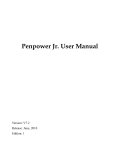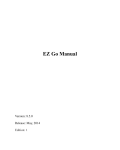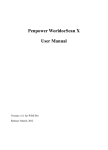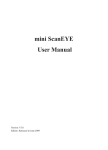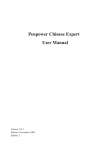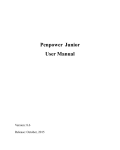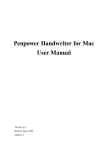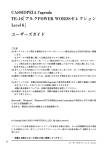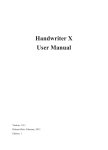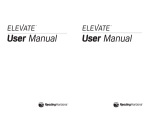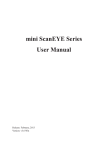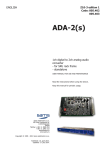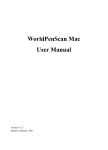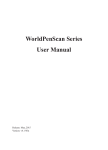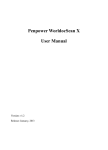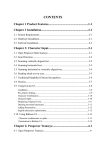Download Penpower Handwriter User Manual
Transcript
Penpower Handwriter User Manual Release: October, 2009 Version: 11.1 Edition: 6 Penpower Technology Ltd. Software User License Agreement You are licensed to legally use this software program (“the Software”) by Penpower Technology Ltd (“Penpower”) under this license agreement (“The Agreement”). If you do not agree with any of the provisions in this Agreement, please do not install, copy or use the Software. By using the Software, you are deemed to fully understand and accept the provisions of this Agreement. 1. Intellectual Property All intellectual property rights in the Software, together with all information and documents included in the packaging for the Software (including but not limited to copyrights), are property of Penpower, and are protected by relevant laws and regulations. 2. License to Use You are authorized to use the Software on one (1) single computer only. You may not use the Software on any other machines other than the said single computer. 3. Authority to Copy The Software and all documents included with the Software, and copyright thereof, are property of Penpower. You are licensed to make one (1) copy of the Software for your personal backup purposes. All other acts of copying are strictly prohibited. You may not sell, lease, dissemble, reverse engineer, copy, translate, adapt or derive the Software, or obtain the source code of the Software by any other means. You may not use the Software for any purposes other than those permitted under this Agreement. 4. Business Users If you need to install or use the Software on more than one (1) computer, please contact Penpower or our local distributor to purchase a license for the additional use. 5. Liability You agree to indemnify Penpower against all losses, costs, debts, settlement payments or other expenses (including but not limited to attorneys fees) arising from your breach of this Agreement, and you agree to compensate Penpower for all of the abovementioned damages. 6. No Warranty Effectiveness of a packaged software in handling information is closely related to its software and hardware environment. The Software is published following careful development and product testing by Penpower, but Penpower is not able to conduct tests based on all possible combinations of software and hardware environment. Therefore, Penpower is unable to promise nor warrant that there will be absolutely no risk of loss or damage of information, or any other kind of loss, during installation and/or execution of the Software. You must be fully aware of your risks in using the Software. Penpower will provide you with the Software and support services in respect of the Software to the maximum extent permitted by law. However, Penpower does not warrant that the Software and information included in the package of the Software contain no defects or errors. Penpower is not liable for any indirect, special or incidental loss arising from the Software, including but not limited to loss of profits, damage to business reputation, cessation of work, hardware malfunction or damage, or any other commercial damage or loss arising from commercial use of the Software. 7. Limitation of Liability and Damages The maximum amount of compensation payable by Penpower, in respect of any damage incurred by you for any reason under this Agreement, is limited to the amount you have already paid to Penpower in respect of the Software. Under no circumstances will Penpower be held liable for the possibility of loss, notwithstanding Penpower may be aware of the possibility of such loss. 8. Prohibition Against Sublicense You are prohibited to assign the license in respect of the Software granted to you under this Agreement, or to grant a sublicense to another person. 9. Jurisdiction With regards to any disputes arising from this Agreement, Penpower and you agree that the court having jurisdiction over the business location of Penpower will be the court in the first instance. 10. Miscellaneous In the event that any provision of this Agreement is found to be invalid at law, such invalidity will not affect the validity of any other provisions, or the legal enforceability of such other provisions. In the event that the Software cannot be executed under conditions of normal use, due to any damage to the original disk/s, Penpower will replace the disk/s free of charge. Contents Chapter One: Product Features............................................................. 1-1 Chapter Two: System Installation.......................................................... 2-1 2.1 System Requirements:............................................................................... 2-1 2.2 Hardware Installation................................................................................ 2-1 2.3 Software Installation................................................................................. 2-2 2.4 Launching Penpower................................................................................. 2-5 2.5 Registration............................................................................................... 2-6 Chapter Three: Penpower Full Screen................................................... 3-1 3.1 Relationships among the Pen, Pad, and Screen........................................ 3-1 3.2 Penpower Full Screen Execution.............................................................. 3-1 3.3 Balloon Interface....................................................................................... 3-2 3.4 Viewing Window Interface....................................................................... 3-2 3.5 How to write Chinese characters.............................................................. 3-3 3.6 Input Method............................................................................................. 3-3 3.6.1 Homophone....................................................................................... 3-3 3.6.2 Duplicator.......................................................................................... 3-4 3.6.3 Character-To-Phrase Inputting ......................................................... 3-4 3.6.4 Punctuation Symbol ......................................................................... 3-6 3.6.5 Editing Symbols................................................................................ 3-7 3.6.6 Handwriting Checking....................................................................... 3-7 3.6.7 Tutor in Phonic and Stroke Order...................................................... 3-7 3.6.8 Auto Phrase Correction...................................................................... 3-8 3.7 Recognition Result Correction.................................................................. 3-9 3.7.1 Penpower Artificial Intelligence........................................................ 3-9 3.7.2 Use by Related Character................................................................ 3-10 3.7.3 Merge................................................................................................3-11 3.7.4 Split...................................................................................................3-11 3.7.5 Phrase Correction............................................................................ 3-12 3.8 Signature................................................................................................. 3-13 3.9 On-Line Translator.................................................................................. 3-15 3.10 Penpower Full Screen Setup................................................................. 3-16 3.10.1 General Setting.............................................................................. 3-16 3.10.2 Inking Setting................................................................................ 3-17 3.10.3 Recognition Setting....................................................................... 3-18 3.11 Pause Handwriting Function................................................................. 3-19 3.12 Exit Penpower Full Screen.................................................................... 3-19 Chapter Four: Penpower Intelligent Writing Pad................................ 4-1 4.1 Launching the Penpower Intelligent Writing Pad..................................... 4-1 4.2 Introduction to the Intelligent Writing Pad Interface................................ 4-1 4.3 Input Methods........................................................................................... 4-4 4.3.1 Basic Input Method........................................................................... 4-4 4.3.2 Using the Related Phrase to Input Chinese....................................... 4-4 4.3.3 Using Homophone to Input Chinese................................................. 4-6 4.3.4 Symbol Input..................................................................................... 4-7 4.4 Editing Text in the Editing Area................................................................ 4-8 4.4.1 Using the Gesture Input Tool............................................................. 4-8 4.4.2 Overwrite/Insert Text......................................................................... 4-8 4.4.3 Candidate Characters and Penpower AI............................................ 4-9 4.4.4 Related phrase Character................................................................. 4-10 4.4.5 Phrase Correction.............................................................................4-11 4.4.6 Speech and Stroke Order Tutorial................................................... 4-12 4.4.7 Pronunciation................................................................................... 4-12 4.5 Habitual Data.......................................................................................... 4-13 4.5.1 Inputting Habitual Data................................................................... 4-13 4.5.2 Editing Habitual Data Information.................................................. 4-13 4.6 Signing a Document................................................................................ 4-17 4.7 Online Translator..................................................................................... 4-17 4.8 Penpower Intelligent Writing Pad Setup................................................. 4-17 4.8.1 General Setting................................................................................ 4-18 4.8.2 Inking Setting.................................................................................. 4-18 4.8.3 Recognition Setting......................................................................... 4-19 4.8.4 Layout Setting................................................................................. 4-20 Chapter Five: Penpower Learning Tool................................................. 5-1 Chapter Six: Penpower Input Tool......................................................... 6-1 Chapter Seven: Penpower Assistant Tools . .......................................... 7-1 7.1 Penpower Notes........................................................................................ 7-1 7.1.1 Open Penpower Notes....................................................................... 7-1 7.1.2 Note’s Three Features........................................................................ 7-1 7.1.3 Alarm Setting..................................................................................... 7-2 7.1.4 Send Notes by E-Mail ...................................................................... 7-2 7.1.5 Delete Notes...................................................................................... 7-2 7.1.6 Notes Manager................................................................................... 7-2 7.2 Penpower Voice Reader ........................................................................... 7-3 7.2.1 Open Penpower Voice Reader........................................................... 7-3 7.2.2 Voice Reader Setting.......................................................................... 7-4 7.2.3 Exit Penpower Voice Reader ........................................................... 7-4 7.3 Penpower Voice Navigator........................................................................ 7-5 7.3.1 Open VoiceNavigator......................................................................... 7-5 7.3.2 Voice Command Window.................................................................. 7-6 7.3.3 Surf Websites with Voice Commands................................................ 7-8 7.3.4 Exit Penpower VoiceNavigator........................................................ 7-10 7.3.5 VoiceNavigator Lists........................................................................7-11 7.4 Penpower Translator .............................................................................. 7-13 7.4.1 English Words.................................................................................. 7-13 7.4.2 Chinese Characters.......................................................................... 7-13 7.4.3 English Chinese Article Translator.................................................. 7-14 7.4.4 Chinese English Article Translator.................................................. 7-14 7.4.5 Button Functions............................................................................. 7-15 7.5 Penpower Artist....................................................................................... 7-16 7.5.1 Card or Letter Design...................................................................... 7-16 7.5.2 Setting.............................................................................................. 7-18 7.6 Penpower User Setting............................................................................ 7-19 7.6.1 Multi-user........................................................................................ 7-19 7.6.2 Pan-Asian All-In-One Package........................................................ 7-20 7.6.3 Button Options................................................................................. 7-20 7.7 Penpaper Wizard..................................................................................... 7-21 7.8 Using Penpower Jr. in MSN Messenger................................................. 7-23 7.9 Office 2003 Trace Mark.......................................................................... 7-24 Chapter Eight: Penpower for Net Handwriter..................................... 8-1 8.1 Open Penpower for Net Handwriter......................................................... 8-1 8.2 Introduction to the Net HandWriter Interface........................................... 8-2 8.3 Setting ...................................................................................................... 8-3 8.4 Tablet predetermined function areas......................................................... 8-4 8.5 Usual Data Setting.................................................................................... 8-5 Chapter Nine: Penpower Writing Pad................................................... 9-1 9.1 Open Penpower Writing Pad..................................................................... 9-1 9.2 Introduction to the Writing Pad Interface.................................................. 9-2 9.3 Input Method............................................................................................. 9-3 9.4 Penpower Writing Pad Setup.................................................................... 9-4 FAQ..................................................................................................... FAQ-1 The software application may have a newer version at the time when this product was being manufactured and/or packaged. If the content on your application screen differs from your User Manual, please follow the latest application screen upon installation. Chapter One: Product Features Chapter One: Product Features Pan-Asia all-in-one package: Recognizes over 23,000 traditional and simplified Chinese characters, 4,818 special Hong Kong Chinese characters(HKSCS2001), English letters, symbols and numbers, Japanese Kanji, Katakana and Hiragana, Korean Chinese characters and Korean. Supporting Unicode: Its recognition kernel is based on Unicode; you can input any traditional and simplified characters. Tablet Short Cut: Allows users to self-define functions on the writing tablet for launching signature, frequently used word and phrases, website browse with one touch on the tablet. Cursive writing Recognition: Capable of recognizing extremely cursive handwriting accurately. Intelligent Recognition Learning Function: Adapts to your handwriting styles and thus becomes your highly personalized handwriting recognition system. No Particular Writing Order: No particular stroke order is required for accurate character recognition. Automatic Correction Function: With the built-in vocabulary and phrases database for proof reading, the system automatically corrects the recognition results. Inputting Frame: Multiple inputting frames allow continuous inputting of characters, compatible with a variety of application software. Full-Screen Inputting: Allows you to write continuously many characters at a time. It can be used together with software application such as MS Office series. 1-1 1-2 Transparent Signature: You can put your signature anywhere in your Word or Excel documents, even overlapping on top of your documents. Signature can also be inserted into e-mail such as Outlook or Outlook Express etc. and be sent along with e-mail. Post-It Notes: You can create post-it notes with your original handwriting, drawings, text, and voice message. Notes can be sent via e-mail. Character-To-Phrase by Extension: Speeds up inputting with the powerful word/phrase by extension so that inputting of one character can lead to proverbs or phrases starting with that character. Homophone Inputting: Allows you to input Chinese characters of homophonic in Chuying, Pinyin and Cantonese Pinyin. Displaying Phrases Pre and Post Character: Displays related phrases with current character as either pre or post character. Learning Pronunciation and Stroke Order: Pronounces each recognized character in either Mandarin or Cantonese, and displays the correct order of stokes. Full-text Reading: Reads out the whole Chinese text in either Cantonese or Mandarin. Pen Style, Stroke Color and Sound Effects: Provides several pen styles, such as brush and fountain pen, as well as single or multicolor strokes. It also provides 23 writing sound effects to make writing more fun. Dictionary and Inputting Tools: Provides dictionary by radical or number of strokes for checking Chinese characters. Also included in the system are Chuying, Pinyin and Cantonese Pinyin inputting methods. Translation: Builds in with cursor-point dictionary for English and Chinese two-way word translation. Chapter One: Product Features Multiple Inputting Interface: Provides multiple inputting interfaces for you to choose from, including bubble interface that displays recognition candidates at the cursor point as soon as a character is written. Penpower Artist: Provides over a hundred of letter and post card templates for you to make personalized letters and postcards in their own handwriting with great graphics. Voice Command: (Supports Windows XP Only) Controls the operation of Windows, as well as browsing web pages in IE with voice commands. MSN Messenger Pen Tracing Function If you have MSN Messenger 6.1 or above installed, you will be able to transmit handwriting and hand-drawn graphics through MSN Messenger for that extra personal touch. 1-3 1-4 Chapter Two: System Installation Chapter Two: System Installation 2.1 System Requirements: 1. Intel Pentium processor or compatible 2. 64MB RAM 3. 180MB disk space 4. Windows 7/Vista/XP 5. USB port 2.2 Hardware Installation USB tablet installation Directly plugs into USB slot. Handwriting Pen Button Functions The button of the pen acts as the right-click of the mouse. The tip of the pen acts as the left-click of the mouse. Note: Handwriting’s styles should be based on the real product. You may go to “Penpower User Setting” to active the button function. Please refer to “7.6.3 Button Options” for details. 2-1 2-2 2.3 Software Installation 1.Insert Penpower handwriter CD into CD-ROM, execute setup.exe if it doesn’t autostart, then choose “Install Handwriting”. Note: The installation items above is for LLC 403 version, other versions will be different. 2. Please select the language version to install then press “OK”. At this point the system will remind you to close all Penpower applications. When all Penpower applications are closed, press “OK”. This will open the welcome screen of the installation process. Press “Next” to continue. Chapter Two: System Installation 3. Please check that you have connected the tablet to the computer, then tick and select “Yes, my tablet is connected”. Press “Next” to continue. Note: If you do not tick and select “Yes, my tablet is connected”, you would not be able to continue the installation. 4. Select installation folder. Click “Next”. 5. Select installation type: Typical, Compact or custom. Click “Next”. Note: If you chose to perform a custom install you will be able to select the functionalities that you wish to install. The Penpower for Net, Penpower Writing Pad and Penpaper Wizard will only be available if selected through a custom install. 2-3 2-4 6. Select program folder, then click “Next”. 7. Select Language. Click “Next”. 8. Click “Finish” to complete the wizard. Chapter Two: System Installation 9.Then continue to install the tablet driver. Each type of table has its own driver. According to the model of the tablet, please select the matching tablet driver and click “Next”. Please follow the prompting screen and install the tablet driver. Tip: If you do not know the model of the wireless tablet, please refer to the front or the back of the tablet or the package for the model number. 2.4 Launching Penpower Run “Start/All Programs/Penpower Handwriting”, there are Penpower Writing Tools, Penpower Assistant Tools, Penpower Start-Up and Uninstall Penpower Handwriting for choose. Please select the function that you want to use from the Penpower Writing Tools or Penpower Assistant Tools. For example, select “Penpower Full Screen” from the “Penpower Writing Tools” menu. Tip: After Penpower is installed, every time the system starts up the system tray in the lower right corner of the computer screen will show the Penpower quick launch icon. You can choose the functionalities you wish to use from the Penpower quick launch toolbar. 2-5 2-6 2.5 Registration When running the Penpower full screen first time, a register reminder window will pop up to remind you registering your product at www.penpower.net/reg.html for ensuring the warranty service. Click “Register now” to register. If you click “Register later”, you may go to “About/Register” when you need. Chapter Three: Penpower Full Screen Chapter Three: Penpower Full Screen Penpower is an environment of full screen continuous handwriting. It can be used together with software application such as Office 2000/XP, and you can write anywhere on the screen. The recognized characters are sent to the cursor location. There are three user interfaces: popup interface and viewing window interface. In this manual, we focus on popup interface. 3.1 Relationships among the Pen, Pad, and Screen The rectangle area on the tablet is directly matched to the screen. The top left corner of match the left corner of computer screen. When you move your pen close to the tablet without touching it, the pen works as a mouse. When you press the pen against the tablet, it serves as pressing the left button on a mouse. “Writing on the Screen” means writing on the tablet, and the handwriting displays on the screen. It is not physically using the pen to write on the screen. 3.2 Penpower Full Screen Execution 1. Open Penpower shortcut function, and select “Penpower Full Screen”. Or you can execute it from “Start/All Programs/Penpower Handwriting/ Penpower Writing Tools/Penpower Full Screen”. 2. Then, if it is in inline or popup interface, Penpower full screen’s illustration displays in job list on the lower right corner; if it is in viewing window interface, it displays handwriting edit window on the screen. 4. You can switch back and forth among popup, or viewing window interface. Tip: In the viewing window interface, you may directly click on interface. button, switch to human 3-1 3-2 3.3 Balloon Interface Penpower employs a unique popup interface. After character recognition, the result will be directly outputted to the cursor position. You can edit, insert, or delete any character. The visual user interface is completely hidden so that only when you need to use the function window, the visual interface will automatically show up. When you want to correct one character, place cursor on the character, wait for a couple of seconds, the balloon interface will display a list of candidate characters window next to the character for your convenience. Tip: You only need to move cursor on the character without click any mouse buttons. After the candidate character window is opened, you can select a character directly, or use artificial intelligent button, homophonic character button, previous character button, post-related character button or phrase correction button to correct character, you may click on button to look up the phonetic character and click on button to see the character order teachng. Click on button to input ordinary punctuation. Click on button to split one character into two.Click on button to combine two characters into one. Click on button to look up a character’s translation. Note: Balloon Interface can be used in Office, IE, WordPad, but on 64 bit systerm, it can not be used in some software, ext. note. 3.4 Viewing Window Interface During multi-character writing, the character buffer area only saves the last recognized character. If there’s a mistake, you have to correct it immediately. Then press to send out the replaced character to the cursor point. button Tip: The viewing window interface is the only interface where you can toggle writing state, limit handwriting pen as pen-mouse state , writing state only , or mouse state . Chapter Three: Penpower Full Screen 3.5 How to write Chinese characters When you write several Chinese characters, please leave certain spacing between characters; place all the strokes of a single character comfortably close together. When you write a Chinese character in cursive style, it is imperative to write in correct stroke order and finish all strokes. Proper Writing For example, write these three characters “明日月”. Incorrect Display One Notice there is no spacing between those two characters. All the strokes are considered as in one character. Incorrect Display Two The two parts of one character “明” are written too far away from each other. Instead of recognized as “明”, they are recognized as “日” and “月”. 3.6 Input Method 3.6.1 Homophone If you forget how to write some Chinese characters, or they are too complicated to write, you can write simpler homophone to find the character that you would like to input. For example, you want to input 『豫』: 1.Write any homophone of 『豫』such as『玉』. 2.Move the mouse cursor to『玉』 for a couple of seconds for the function tool bar. 3.Move the cursor on the homophone homophones. button to list all the 4.Click / / button to switch into other phonetic notation /Cantonese Pinyin /Chinese Pinyin characters. 5.Select『豫』 to replace『玉』. 3-3 3-4 3.6.2 Duplicator In continuous writing mode, Penpower handwriter will treat as the previous character. If you want to input 『謝謝』, you may writing them as: Note: The “Symbol” mode must be enabled to use the radicals input duplicator method. See the <<3.10.1 Standard Settings>> section for more details on its setup. 3.6.3 Character-To-Phrase Inputting 1. Open Penpower full screen menu; select “Related Phrase”, the phrase window will show up on the screen. 2.When using full screen handwriting, you only need to input the first character of the phrase. For example, if you want to input『一面之詞』, you only need to write the first character『一』. The phrase window will show all the phrases starting with『一』in the top half of the window. 3.The bottom half of the phrase window lists the related characters you wrote before after character『一』. For example, you once wrote『一面』, the character『面』 is 『一』’s related character. 4.Select a phrase or a memory character and send it to the cursor position. Tip: After you select one phrase, this phrase will be adjusted to the first place on the list. This way it’s easier for you to find your most often used phrases. Update Phrase Database Although Penpower provides several hundred thousands default phrases for your use, you can open phrase dialogue box to customize the phrase database to meet your need, such as adding new ones, or looking up and revising customized phrases. We suggest you check it periodically to delete those unnecessary phrases. 1.Open phrase menu, and select “Phrase” to open the dialogue box. Chapter Three: Penpower Full Screen Tip: If you do not want to use the related characters in the phrase database. Please do not click “related characters” in the database menu. 2.Click on “Insert” button to open database input dialogue box to add a new phrase. For example, you want to add our company’s full name into the phrase database, input 『蒙恬科技股份有限公司』. The right side of the box will list each Chinese build-in Chinese and Cantonese Pinyin of this phrase. Please choose the correct Pinyin of each character by clicking / button and listen to it. Note: The maximum number of characters for each phrase is 200 Chinese characters. Since the phrase dictionary and text-to-speech shares the same dictionary, the pinyin input will influence the correct pronunciation in “Penpower VoiceReader”. If it is not important to you, you can ignore it. After inputting, press “Ok” button to add the new phrase. When you write『蒙』, 『蒙恬科技股份有限公司』displays in the viewing window. You may select output directly. 3. Press “Modify” to revise this phrase’s Pinyin from the dictionary; Press “Delete” button to delete the phrase from the dictionary. 4.In “Search string” subject, input the part of the searching string, and the whole string displays. 3-5 3-6 5. You may use “New”, “Open”, “Save” and “Save As” functions to create different database files and classify them into different categories. Note: Although you may create many files, but each times you can only choose one file. 6. Speedy Phrase Creation: You may use “Import” function to choose a file, and merge the data file into the phrase database. The data file’s format is that one phrase per line; you may use any text editor to edit it. Note: When you use data file to import phrases, the system will automatically add pinyin to the phrases. One drawback is pronunciation may not be totally right. You may use phrase dialogue box’s editing function to proofread. 3.6.4 Punctuation Symbol 1.Write a few characters. 2.Move the cursor over the character you want to look up for a couple of seconds for the menu “Candidate Characters Menu” to show up. 3.Press button to open the symbol menu and select and input ordinary punctuation in full or half shape. 4. If you feel these punctuation marks are not enough, Penpower also provides Penpower Basic Symbol function so that you can select and input what you need directly. Penpower Basic Symbol function divided into single page and pair page. Please “單/雙” button to switch. * 單: Select the punctuation button which you want directly. * 雙: If selecting left brace in the punctuation list, a pair of braces will send. For example, select “【” button, “ 【”and “】” two punctuations will be sent. Open Penpower Basic Symbol function to set the display as horizontal or vertical window and to change the contents and tabulate. Chapter Three: Penpower Full Screen 3.6.5 Editing Symbols Penpower provides four standard editing symbols: delete, backspace, enter and space bar. These are as follows: 1. Delete: Delete the character after the cursor. 2. Backspace: Delete the character before the cursor. 3. Enter: Change line in the cursor point. 4. Space: Insert a blank in the cursor. Or 3.6.6 Handwriting Checking 1. Write a few characters. 2. Move the cursor over the character you want to look up for a couple of seconds for the menu “Candidate Characters Menu” to show up. 3. Press button to look up you own writing. 3.6.7 Tutor in Phonic and Stroke Order 1. Write some characters. 2. Move the mouse cursor over the character you want to look up, waiting for a couple of seconds, “Candidate Characters Menu” will be opened. 3.Press button to display the tutor dialogue. If you want to go into active character order tutor, press button. 3-7 3-8 Press button to hear the Mandarin tone pronunciation while the homophonic characters display on the right, in Chuying. Press button to hear the Cantonese ton pronunciation while the Cantonese homophonic characters display on the right, in Cantonese pinyin. Press button to hear the Mandarin ton pronunciation while the Mandarin homophonic characters display on the right, in Pinyin. 3.6.8 Auto Phrase Correction The system automatically proofreads on your writing content to improve the recognition rate. For example, when you continuously write『天下太平』 (peace on the earth) four characters, but the character『天』is incorrectly written as『夫』, so they become 『 夫下太平』. Penpower uses its internal phrase dictionary to correctly recognize your intended result『天下太平』. Chapter Three: Penpower Full Screen 3.7 Recognition Result Correction After you use the candidate character list or artificial intelligent button corrections, Penpower will automatically learn your handwriting style to improve the recognition rate. 3.7.1 Penpower Artificial Intelligence 1.The recognized character is sent to the cursor position. 2.See the illustration for example.『恬』 is wrongly recognized as『恰』. 3.Move the cursor to『恰』, wait for a couple of seconds for the candidate characters to show up. 4.If the correct character is in the candidate list, select it to make the correction. 5.If the correct character is not in the candidate list, click on artificial intelligence button to open artificial dialogue box. 6.Input the right character『恬』, and press “Input Complete” to close the box. 7.Finally you’ll see the correct character at the cursor position. Since the system has learnt your handwriting style, next time the same handwriting of yours will be correctly recognized. 3-9 3-10 3.7.2 Use by Related Character For any two character phrase, the first character is the second character’s “Pre-Related character”, and the second character is the first character’s “Post-Related character”, such as『科技』 (science technology), 『科』 (science) is『技』 (technology)’s pre-related character, and『技』 (technology) is『科』 (science)’s post-related character. 1.Write a few characters. 2.See illustration.『恬』is wrongly recognized as『恰』;『科』(science)is wrongly recognized to as『料』(material). 3.Move the cursor on the character『恰』, and wait for a couple of seconds to the function tool bar to pop up. 4.Click the pre-related phrase button, and all the two character phrases will be listed. If the correct phrase in the list, select it to make the correction. 5.Move the cursor to『料』; wait for a couple of seconds for the function tool bar to pop up. 6.Move the cursor to post-related phrase button, and all the two character phrases will be listed. If the correct two character phrase『科技』is in the list, select it to make the correction. 7. Finally, you see the corrected result of 『蒙恬科技』. Chapter Three: Penpower Full Screen 3.7.3 Merge If you write the left and right parts of a character too far apart, they might be recognized as two characters. You can use the merge function to unite them into one character. 1. Write『棟樑』, see illustration. 2.If『木』and『東』are written too far away from each other, you may wrongly get three characters『木東樑』. 3.Move the cursor on the first character『木 』and wait for a couple of second for the function tool bar. Click merge button, to combine『木』(wood) and『東』(east) together as『棟』(beam). 3.7.4 Split When two characters are written too closely, they may be treated as one character. You can use split function to separate it into two characters. 1.Write『日月星辰』 (the Sun, the Moon, Stars and Galaxies), see illustration. 2. The first two characters are too close to each other; they will be treated as one character. The recognized result is『明 星辰』(Bright, Stars and Galaxies) three characters 3.Move the cursor on the character『明』 for a couple of seconds for the function tool bar. Click on split button to separate the character,『明』, into two characters『日 』and『月』. 3-11 3-12 3.7.5 Phrase Correction In Full Screen mode if you wish to enter a common phrase such as an idiom, if you aren’t sure of how to write one of the characters you can substitute a similar sounding character instead. If you are not sure of the character’s pronunciation either, choose any at random. When you have finished writing the phrase, select the uncertain character with the mouse then click on the phrase correction button. The system will examine the four characters before or after this particular character to guess what you meant and make the change. 1.When entering an idiom in Full-Screen mode such as『拔苗助長』, if you are not sure of how to write the character『拔』, you can enter the character『一』instead to input『一苗助長』. 2.Move the mouse over the character『一 』and pause for a moment to bring up the “Candidate Characters Window”. Click the phrase correction button and the『一』 character will be changed to『拔』. 3.If the phrase correction function came up with multiple candidate words, these will be shown in the candidate words window for you to choose from. For example, if the input was『股份一限公司』when you pause the mouse cursor over the『一』 character, this will bring up the “Candidate Characters Window”. Pressing the phrase correction button will bring up a list of all phrase correction candidate words for you to choose and make the correction with. Chapter Three: Penpower Full Screen 3.8 Signature 1.Move the cursor to the place you want to sign in your document. 2.Press “Signature” to enter the signature mode. Note: Only applications with image and characters capabilities have the signature function, such as Word, WordPad or Excel. 3.Draw or sign your name any place in the screen. Set ink color: Set ink width: Set pen style: Delete all of the writings, and re-sign: Restore one signature: Delete restored signature: 4.Press button to delete the signature. 5.Press button to finish the sign and insert the signature next to the cursor. Usually, a signature also may insert a letter in IE, Netscape, or Eudora, and send to others through e-mail. 3-13 3-14 6.Press button to finish transparent signature so that your signature is overlapping on the document. Note: You can use the transparent signature in the latest Word and Excel, but Office 2007 not support this function. You may make notes and commentary by using transparent signature function. Chapter Three: Penpower Full Screen 3.9 On-Line Translator Open Penpower full screen main menu, and select “On-Line Translator” to open online translation function. Select it again to close the function. When reading English or Chinese articles, if you encounter unknown characters or phrases, move the cursor over the characters, and a translation window pops up to explain them for you. English Translation When you move the cursor outside the interactive scope, the window will disappear. In the window, you can press the play button or character / or phrase explanation buttons. The online translation is used in the balloon interface. When you want to look up a character’s translation, select button from the candidate window. Chinese Translation 3-15 3-16 3.10 Penpower Full Screen Setup Open Penpower full screen menu and select “Penpower Full Screen Setting...” to open the setting dialogue. You can configure the recognition mode, writing speed, writing inking and output format here. 3.10.1 General Setting Recognition Mode Setting Penpower provides Chinese, English, Numeral, Symbol, and Japanese five recognition modes. Select the only those recognition modes you want to improve the recognition rate. Note: In Japanese recognition, there are only hiragana and katakana. You must switch to Japanese edition to input Japanese kanji. Please refer to 7.6 section to see the details. Multi-Words Writing/ One word Writing Please select and open “Multi-Words” option, you can write up to 45 characters at a time. If you are new to handwriter, or not yet used to handwriting, you may turn this option off. Your writing will be deemed as one character to recognize to avoid mistakes in character segmentation. Writing Speed Adjustment Penpower provides ten speed scales (1~10), the small the number, the shorter the time for the recognition engine to kick in. Use bigger number if your handwriting is slow. Full shape /Half shape Set recognition result of English, number and symbol and output in full or half code. English appliciation Press backspace one time in Chinese software, it will automatically delete backward two bytes (one character in Chinese) while it will only delete one byte (half Chinese) in some English software. Please select this option when you use English software to avoid mistakes of candidate character correction. Chapter Three: Penpower Full Screen Add black Next to Chinese If the lines do not aligned well with English software, please check this selection, so that it will automatically add a space to align up. Open Balloon help When you move the cursor to any button for about two or three seconds, a concise explanation pops up. If you do not want it, you can turn this function off. Sound Pronounce the character in Mandarin or Cantonese immediately after recognition. 3.10.2 Inking Setting Switch to “Inking” title page. Ink Color: Set font color. In “Multiple” selection, adjust color change smoothness. Ink Width: Set the line’s levels of thickness.. Pen Sound: Set sound effect as you write. Pen Style: Choose from one of the eight pen styles such as Mark pen, Chalk and Writing brush. You can also set pictures as the texture for your pen style. In Pen Style select “Texture mapping”, then press the “Browse” button to bring up the “Open” dialogue. The system offers 10 default graphics but you can also choose other pictures you like on the computer. Press “Open” to set the selected picture as the texture map for your pen style. Note: Only *.bmp format pictures supported for pasting. 3-17 3-18 3.10.3 Recognition Setting Switch to “Recognition” title page. You can choose the output characters, either in Traditional Chinese, Simplified Chinese or Traditional+Simplified, no matter how you write them and how the recognition kernel setting is set. Traditional Character: No matter whether you write traditional or simplified characters, the recognition result is displayed as traditional characters. Simplified Character: No matter whether you write traditional or simplified characters, the recognition result is displayed as simplified characters Traditional+Simplified : When you write traditional characters, they show up as traditional characters; When you write simplified characters, they show up as simplified characters. Penpower allows you to use traditional or simplified writing method to input any Chinese character, or mixed them. For example, you may input 『書寫』as belowe. Unusual Character: This recognition mode is only available when the Penpower is set to the Simplified Chinese version. Check this option to recognize other extremely rare Chinese characters. Runnig hand: Check this option to have the software recognize run-on cursive. Chapter Three: Penpower Full Screen Hongkong character: This recognition mode is only available when the Penpower is set to the Traditional Chinese or Traditional Chinese (Hong Kong) version. You can connect to http:// www.microsoft.com/hk/hkscs/default.aspx to check the Hong Kong characters list. 3.11 Pause Handwriting Function If you want to close the handwriting function temporarily and use the pen as a mouse, please open Penpower full screen main menu and select “Suspend” . Penpower full screen on the lower right corner’s illustration will turn into state to tell you the handwriting function is closed. Select “Suspend” one more time, the handwriting function will be restored. 3.12 Exit Penpower Full Screen 1.Open Penpower full screen main menu. 2. Select “Exit”. 3-19 3-20 Chapter Four: Penpower Intelligent Writing Pad Chapter Four: Penpower Intelligent Writing Pad The Penpower Intelligent Writing Pad is a handwriting input tool based on writing cells. With a comprehensive set of editing function buttons integrated into the interface, the user can edit their text with ease. The user can also customize and quickly insert symbols, common words and their signature file. 4.1 Launching the Penpower Intelligent Writing Pad From the PenPower quick launch toolbar select “Penpower Intelligent Writing Pad” and it will appear on the desktop. Tip: When the cursor is moved away from the Penpower Intelligent Writing Pad it will automatically minimize into an icon to save space on the screen. The Intelligent Writing Pad status will pop up when the cursor moves over this icon. 4.2 Introduction to the Intelligent Writing Pad Interface Shortcut Editing Tool Hide/Show Editing Field Buttons General Input Area English input in lower case Number input Symbol input General Input Area: Text input can be written here. The area can be set to contain 1~5 cells, with 1 cell being for single character input and 2~5 fields for multiple characters. See the chapter on Settings for further details on setup. Hide/Show Window Button Toolbar Editing Area Gesture Input Tool Editing Area English input in upper case 4-1 4-2 English inputin upper case: All text sent from here appears as alphabetical uppercase. English input in lower case: All text sent from here appears as alphabetical lowercase. Numerical Input: All text from here appears as Arabic numerals. Symbolic Input: All text sent from here appears as symbols. Hide/Show Window Button: Pressing this button hides or shows the alphabetical, numerical and symbolic input fields. Editing Area: All text inputs will be temporarily stored here. The editing tools can be used to change the text here before they are sent. Editing Area Gesture Input Tool : From left to right these are: Send or Revert character(s) to the target apllication, Delete key in the buffer, Backspace key in the buffer, Space key in the buffer and Enter key in the buffer. Note: Pressing the send button sends the text in the editing area to the application and changes the send button to revert . Shortcut Editing Tool: Allows the quick input of symbols, candidate characters, homonyms, quick correcting of previous/next associated character or even entire text strings based on associated terms. Press the show more information. Candidate Characters Field Homophone Field Pre-Related phrase Field Post-related phrase Field Phrase Field Expanded to show more information Frequently Used Symbols Field button to Hide/Show Editing Area Button: There is no limit to the length of text that the editing field can hold so pressing this button hides or shows the editing field. In edit mode, the user can check and make basic edits to the input text before pressing the button again to hide the editing field. The edit cache field will then only show the last row of text entered. Text Cache Field Status Toolbar: The function buttons in this area will open the corresponding function window or perform the corresponding action. 4-3 Chapter Four: Penpower Intelligent Writing Pad Overwrite/Insert Mode Full/Half shape Setting Usual Data Edit phrase Add the selected phrase into the Userdefined phrase Database Library Signature Symbol Phrase ON-Line Translator Speak Standard inking tutor Phrase Correction Artificial Intelligence Function 4-4 4.3 Input Methods 4.3.1 Basic Input Method After Chinese is entered into the General Input Area or English characters/symbols are entered into the English, numerical or symbolic input fields, the recognition results will be displayed in the editing area. Pressing at this time will then send the text to applications such as Word/Excel. Once the text in the editing area has been sent the button will change to been sent to the application, press the Intelligent Writing Pad’s editing field. . If you wish to revise text that has already button to revert the sent text back to the Note: Punctuation, symbols, numbers and lowercase alphabetical characters can appear as Half or Full Form. When the toolbar status is will change it to for half shape input. it is full shape input and pressing this button 4.3.2 Using the Related Phrase to Input Chinese Using the Related Phrase to Input Chinese. When you input a character the phrase field will display a series of phrase terms that start with this character. You can also press the button behind the phrase field to look up for phrases. If the term that you want appears in the window, click on it to enter the entire term without having to enter all of the other characters. If you wish to input “一視同仁”, simply input “一” and then choose from the phrase terms window “一視同仁” to finish inputting the entire phrase. Hint: When you use a suggested term it will be moved to the front of the list the next time the same situation arises so you can easily access your frequently used terms. Chapter Four: Penpower Intelligent Writing Pad Editing Phrase Press the “Edit Phrase” button in the toolbar to open the Phrase window. Note: The methods for editing and changing the dictionary are identical to that for Penpower Full Screen mode. Please see Chapter 3 3.6 for further details. Apart from using the “Insert” method described above to add new associations to the dictionary it is also possible to select the desired text in the editing area and press the toolbar button . If you wish to input “一不做二不休” and add it to the phrase dictionary, use the mouse to highlight the text then press the button to open the “Phrase Input” dialogue. First correct the heteronyms then press “OK” to add this term to the dictionary. The next time that you write the character “一” the term will appear among the suggested phrase. 4-5 4-6 4.3.3 Using Homophone to Input Chinese Sometimes how a Chinese character is written is forgotten or is complicated to write. When this happens an easier to write character that sounds the same can be substituted with the homophone function used to find the desired character. For example, if the desired character was “豫”, enter any homophone such as “玉” and the recognition result will be sent to the editing area. Now check in the homophone field for the character “豫”. If it does not appear, press the homophone field’s to show the homophone window. Now select “豫” to change “玉” to “豫”. button Tip: If the character that you entered has multiple pronunciations , the homonym field will by default show the homonyms for the most frequently used pronunciation. Clicking on this character in the editing field will refresh the homonym field area to display this character’s homonyms for other pronunciations, with each click changing to another pronunciation. For example, the input “大” has two possible pronunciations. By default the homonyms for “dà” are displayed. Clicking on the character “大” will change the display to show the homonyms for “dài” instead. Chapter Four: Penpower Intelligent Writing Pad 4.3.4 Symbol Input You can input punctuation marks and symbols directly by writing them in the “Symbol Input” or you can choose from any symbol in the frequently used symbols field. Additionally, you can press the button behind the frequently used symbols field to show further symbols. These can then be selected and used for input. Note: Punctuation, symbols, numbers and lowercase alphabetical characters can appear as Half or Full Form. When the toolbar status is it is full shape input and pressing this button will change it to for half shape input. By default the frequently used symbols field is set to display six symbols: ,。、; :!. You can redefine what symbols are displayed in the frequently used symbols field. Press the button behind the frequently used symbols field and move the mouse cursor to the symbol that you wish to add to the frequently used symbols field such as “√”. Clicking on it with the mouse and pausing for around 3 seconds will bring up a menu. Select “Add this symbol to common user area” and the “√” will now show up at the front of the common used symbols field. All of the other symbols will be moved back by one place with the symbol in the last place removed. Note: If currently in Full Shape Input mode then only the fullform symbols can be added to the frequently used symbols field. If currently in Half Shape Input mode then only the half shape symbols can be added to the frequently used symbols field. 4-7 4-8 4.4 Editing Text in the Editing Area 4.4.1 Using the Gesture Input Tool 1.Write the Chinese in the input field and the recognition results will appear in the editing field. 2.Select the text to edit. To select multiple characters click and drag with the mouse button. Press the button to delete the selected text. 3.Press the button to delete the character before the selected text. 4.Press the button insert a space behind the selected text. 5.Press the button to add a new line behind the selected text. 6.Press the button to send the text in the editing field to where the cursor is located within the application. After the text is sent it will change to the revert button. Press the to revert the previously sent text to the editing field. 4.4.2 Overwrite/Insert Text The toolbar will show the current editing field text mode. When the button is it is in overwrite mode. Pressing the button will change it to insert mode. Pressing button again will change it back to the overwrite mode. 1.Write the Chinese in the input field and the recognition result will be sent to the editing field. 2.If the text was not recognized correctly, select the text to edit (click and drag to select multiple characters) and enter the new text in overwrite mode. This will replace the selected character or text with the new input. 3.To insert text, set the status to insert mode then select the character located before the point you wish to insert the new text at. Enter the new text to insert it behind the selected character. Note: To insert text in front of the first character in the editing field, please click to the left of this character by about one-thirds of the character’s width. This allows you to input new text in front of the first character. Chapter Four: Penpower Intelligent Writing Pad 4.4.3 Candidate Characters and Penpower AI 1.Write the Chinese in the input field and the recognition result will be sent to the editing area. If the recognition was faulty the candidate characters function can be used to fix characters that are wrong. For example: When writing “蒙恬科技” the “科” was mistakenly recognized as “料”. Click on the “料” character in the editing field then check if the candidate characters field contains the correct “科”. If yes, select it to make the correction. Note: The candidate characters field will display at most 6 candidates. Any character you select will then be moved to the front. 2.If the candidate characters field does not show the correct word for use, click on the “Artificial Intelligence function ” button in the toolbar to bring up the Artificial Intelligence window. Enter the correct character “科” then click “ OK” to close the Artificial Intelligence window. You will now find the incorrect character “料” changed to “科”. The software will also learn from the trace of how you wrote the character so it will recognize it properly next time. 4-9 4-10 4.4.4 Related phrase Character In any two linked characters (two-character term) the first character is the Pre-Related phrase character for the second character while the second character is the first character’s Post-related phrase character. The term “科技” for example has 科 as the Pre-Related phrase character of 技 while 技 is the Post-related phrase character of 科。 1.Write the Chinese in the input field and the recognition result will be sent to the editing field. If a two-character term was not properly recognized, the Pre/Post-related character function can be used to fix the incorrect character. For example: When writing “蒙恬科技” the character “恬” was incorrectly recognized as “恰” and “科” mistaken as “料”. 2.Use the mouse cursor to select the “蒙” character in the editing area then check the Post-related character characters field to see if the correct character “恬” is available. If yes then click on it to add “恬” directly behind “蒙”. If the next associated characters field does not show the correct character, click on the button to open the Postrelated character characters window to look for more options. Upon finding “恬”, click on it to add it behind “蒙”. Now click on “恰” then click on the button in the Gesture Input Toolbar to delete it. 3.Click on the “技” character in the editing field then check for the correct character “科 ” in its Pre-Related phrase characters field. If yes then click on “科” to insert it directly in front of “技”. If the Pre-Related phrase characters field does not show the correct character, click on the button to open the Pre-Related phrase characters window to look for more options. Upon finding “科”, click on it to add it in front of “技”. Now click on “料” then click on the button in the Gesture Input Toolbar to delete it. Chapter Four: Penpower Intelligent Writing Pad Hint: You can also use the Pre/Post-related character function to enter two-character terms. For example, if you wish to enter “蒙恬” you can input “蒙” first then use the Post-related characters window to input “恬”. To enter “科技”, you can enter just “技” then use the Prerelated characters window to input “科”. 4.4.5 Phrase Correction 1.Write the Chinese in the input field and the recognition result will be sent to the editing area. If it’s a term or phrase in common usage but you aren’t sure of how a character is written or even pronounced, you can substitute any other character instead. The Phrase Correction function can then be used with the other 4 characters in front and after this character to guess the correct answer then fix it. For example: For the phrase “天下為公” you aren’t sure of how “為” is supposed to be written or even pronounced. At this point, you can substitute any character such as “一 ” instead. 2.In the editing area, use the mouse to select the character “一” then press the button on the toolbar. This will guess the correct character and at the same time change “一” to “為”. 4-11 4-12 4.4.6 Speech and Stroke Order Tutorial All text in the editing field can be selected then its proper trace looked up using the button on the toolbar. So if you didn’t know how to write the character “為” then fixed it using the text prediction function, you can now select “ 為” then click on the button to open the standard trace tutorial window. This will show you how to write the character as well as how it’s pronounced in Pinyin, Hanping and Cantonese. Note: For more information on stroke order tutorial please see Chapter 3.6.7 Tutor in Phonic and Stroke Order. 4.4.7 Pronunciation All text in the editing field can be selected then the to play its Mandarin or Cantonese pronunciation. button on the toolbar pressed Note: You can select multiple characters to have an entire sentence or paragraph read out aloud. Note: To set the language used for pronunciation, please refer to Chapter 4.8.1 General Setting. Chapter Four: Penpower Intelligent Writing Pad 4.5 Habitual Data 4.5.1 Inputting Habitual Data *Inputting Pharse Press the “Phrase” it in the editing field. button to open the Phrase list. Select the term to input to place *Inputting Symbols Press the “Symbol” button to open the symbols list. Select the symbol to input to place it directly in the application at the cursor’s location. Note: The symbol will be inserted directly to the application and not cached in the editing field. *Inserting Signature Press the “Signature” button to open the signature files list. Select “Signature File” and open the frequently used signature files list to select the signature you wish to insert. The signature will be inserted directly in the application at the cursor’s location. Note: The symbol will be inserted directly to the application and not cached in the editing field. Note: If the “Sending the first one directly” option is checked when editing the signature file, pressing “Signature File” will directly send the first signature file set. For more details see Chapter 4.5.2. Phrase Symbol Signature 4.5.2 Editing Habitual Data Information The edit Habitual Data information function can be used by the user to edit/add Phrase, symbols and signature files. Including them in the Usual Data items allows them to be quickly added to the document being edited. Press the “Phrase” button to open the Habitual Data information window. Three tabs are available: “Symbol”, “Phrases” and “Signature”. 4-13 4-14 * Emoticons: 1.Select item on the right and press the button to add it to the “Habitual Items” category and it will be available from the “Symbols” list. Note: The maximum number of Habitual items is 10. 2.Press the “New” button to open the Add New Symbol window. You can choose to insert a symbol or input it directly with the keyboard. Press “OK” to add a new Symbol to “All Items”. Note: The Symbol must be less than 10 characters in length. 3.Select a symbol and press the “Edit” button to open the edit emoticon window. The selected symbol can be changed then saved by pressing “OK”. 4.Press the “Export” button to export the current database. 5.When the “Import” button is pressed the user can import a symbol definition file on the computer to the software. When importing, choose whether to import a text or symbol file. If importing a custom text file, please ensure that it’ s in the format specified in the import window. Chapter Four: Penpower Intelligent Writing Pad * Phrases: 1.Select item on the right and press the button to add it to the “Habitual Items” category and it will be available from the “Habitual Items” list. Note: The maximum of number of Habitual items is 10. 2.Press the “New” button to open the Add New Phrase window. You can choose to insert a symbol or write it directly. Press “OK” to add a new phrase. Note: Phrases must be less than 20 characters in length. 3.Select a Phrase then press the “Edit” button to open the edit phrases window. The selected content can be edited then saved by pressing “OK”. 4.Press the “Export” button to export the current database. 5.When the “Import” button is pressed the user can import a phrases definition file on the computer to the software. When importing, choose whether to import a text or phrases file. If importing a custom text file, please ensure that it’ s in the format specified in the import window. 4-15 4-16 * Signature: 1.You can press the “New” button to create your own custom signature file then press the button to add it to the “Habitual Items” category. When adding a new signature, please provide the signature name (maximum length 10 characters) and the signature content (maximum 10 lines with up to 40 characters per line). Note: If the “Sending the first one directly” option is checked when you press the signature file button on the Intelligent Writing Pad toolbar and open the “Signature” menu, the frequently used signature files list will not be shown. Instead, the first signature file in the Habitual data category is sent to the application and inserted where the cursor is. You can therefore move your most Habitual data signature to the front like the “簽名范例” shown above then check the “Sending the first one directly”. Now when you press the and select “Signature” the “簽名范例” will be inserted directly in the application. 2.To import a signature using a custom text file, please ensure that it’s in the format specified in the import window. For example: [begin] My Business Card WANG Tzu-ming [end] button Chapter Four: Penpower Intelligent Writing Pad 4.6 Signing a Document Move the cursor to the location in the document where the signature is to be added. Press the “Signature” button on the Penpower Intelligent Writing Pad toolbar to open the signature files list. Select “Write Signature” to switch to the signature mode. Now you can draw a picture or sign your name anywhere on the screen. For more details on how to use the write signature function please see Chapter 3.8 Signing. 4.7 Online Translator Press the button on the toolbar to enable the online translation function. When enabled, the button changes to . Press this button again to disable the online translation function. When the online translation function is enabled if you see a character or phrase you don’t recognize when reading an English or Chinese article, move the cursor over the section to get a real-time translation and explanation without having to flip through a dictionary. For more details on how to use the online translation function please see Chapter 3.9 On-Line Translator. 4.8 Penpower Intelligent Writing Pad Setup Press the “Setting” button on the Penpower Intelligent Writing Pad toolbar to open the setting screen. There are four tabs and you can click on the tab titles to switch to the pages for each type of settings. 4-17 4-18 4.8.1 General Setting Recognition Mode: Recognition is provided for Chinese, English, Numeral, Symbol and Japanese. The modes can be selected as necessary though selecting fewer modes improves recognition accuracy. Speed: Set the writing delay. The smaller the delay means the shorter the wait before recognition begins after user stops writing. If your writing speed is slower, you can set the “Speed” value higher. Full/Half Shape: Set whether recognized alphabets, numbers or symbols should be output as full shape or half shape encoding. Auto Hideen: With this option selected when the cursor moves away from the Intelligent Writing Pad it will temporarily be minimized to an icon. When the cursor moves over the icon it will automatically display the Intelligent Writing Pad status. Enable Help Wizard: With this option enabled when the cursor is paused over any button for 2~3 seconds a brief description will pop up. To prevent this from being shown turn off this function. Homophone: Choose whether to display homophone using Pinyin, Hanping or Cantonese pronunciation. Sound in edit area: Set whether text in the editing field should be pronounced using Mandarin or Cantonese. Sound after recognition: Set whether a character should be pronounced in Mandarin or Cantonese after recognition. 4.8.2 Inking Setting Ink Color: Set the color to use for the writing trace. In the “Multiple” option the color change gradient can also be adjusted. Chapter Four: Penpower Intelligent Writing Pad Ink Width: Set how thick the writing trace should be. Pen Sound: Set the sound effect to use when writing. Pen Type: There are 8 types of pen types available including Mark pen, Chalk and Writing brush.Your favorite pictures can also be used as the texture map for the writing trace. Note: For details on setting up the pen texture map please see Chapter 3.10.2 Inking Setting. 4.8.3 Recognition Setting Simplified Character: Always output Simplified Chinese whether written as Traditional or Simplified. If Penpower is currently set up for Simplified Chinese then a [Traditional to Simplified] suboption is also available to disable handwriting recognition for Traditional Chinese. If you do not know how to write Traditional Chinese, do not check the “Traditional to Simplified” suboption for improved recognition accuracy with Simplified characters. Traditional Character: Always output Traditional Chinese whether written as Traditional or Simplified. Traditional+ Simplified: When written as Traditional Chinese the output will be Traditional Chinese; when written as Simplified Chinese the output will be Simplified Chinese. Unusual Character: Allows recognition of very rarely used Chinese characters. This option should not be used if possible as it may affect the recognition of standard Chinese characters. 4-19 4-20 Runnig hand: Check this option to have the software recognize run-on cursive. Hongkong Character: When the [Hongkong Character] option is checked the recognition engine will include 4941 characters specific to Hongkong (HKSCS 2001). If you do not need to input Hongkong characters do not check this option. To download the Hongkong character set visit http://www. microsoft.com/hk/hkscs/default.aspx. 4.8.4 Layout Setting Writing box: Configure the interface to use 1~5 cells for handwriting recognition. 1 box allows only 1 character to be written each time. 2~5 box allow multiple characters to be written each time. Skin: Allows the choosing of a color theme. The four colors available are Green, Pink, Silver and Blue. Chapter Five: Penpower Learning Tool Chapter Five: Penpower Learning Tool Use a simple symbol to represent a string of characters to speed up inputting speed. 1.Open Penpower shortcut function, and select “Penpower Learning Tool”. Open the Learning Tool page. Then click on “Learning string” to open the “Learning Tool” dialogue box. 2.Input the phrase you want to study. Then click on “Start” button to switch next page, and write a symbol twice to finish the studying. 5-1 5-2 3. Click on “Manage DB” on the “Learnig Tool” page to look up or revise the learned material. Chapter Six: Penpower Input Tool Chapter Six: Penpower Input Tool Penpower inputting tools are very powerful supplemental tools with handwriting pad, pinyin, keyboard, dictionary, and symbol. It makes life much easier to enter those extremely difficult or rare characters. 1. Open Penpower Menu, and select “Penpower Input Tool”. 2. Penpower input tool contains five inputting methods of handwriting, pinyin, keyboard, dictionary, and symbol. Tip: When you move the cursor away from Penpower handwriting pad, the pad will automatically shrink into to save your screen space. When you move your cursor on , the pad will automatically reappear. Handwriting Input Tool Pinyin Input Tool Keyboard Input Tool Tip: You may select zhuyin, Cantonese pinyin, or hanyu pinyin methods. Dictionary Input Tool Symbol Input Tool 3. Select “Setting” from the Penpower Input Tool menu to open the Setting dialogue, then you can setting the recognition. Please refer 3.10.3 to see the details. 6-1 6-2 Chapter Seven: Penpower Assistant Tools Chapter Seven: Penpower Assistant Tools 7.1 Penpower Notes Penpower Notes is an electronic Post-It.You use Note to make notes whenever you want. In addition to text and drawings, you may even record audio in the notes and then send them to others through e-mail. 7.1.1 Open Penpower Notes 1.Go to Penpower main menu; select “ Penpower Notes”. Then the Notes manager icon will be shown at the right bottom corner of your computer. 2.Right click to open the Notes menu, then choose Add Note and choose one of the five colors to create a new note. 3.You can write, draw, or record audio on the new note. Resize it if necessary. 4. Choose Setting from the Note menu to open the Setup window, then you can select the meaning of Double Click. 7.1.2 Note’s Three Features There are three features for each note. Click the tack on the top of the note to open its menus. Then select all the available tools or functions. Tip: You can only access these three features one at a time. 7-1 7-2 “Graph Wizard” provides the main drawing functions including pencil, fluorescent pen, and so forth, and drawing tools including drawing circle, square and so forth. “Ink Wizard” lets you to write on the note with your handwriting or key in your notes. “Record Wizard” lets you to record audio. 7.1.3 Alarm Setting Click the tack on the top of the note and select “Set Alarm”. 7.1.4 Send Notes by E-Mail If your default mail client is Outlook, you can easily send your notes to your contacts. Click the tack on the top of the note and select “Sent mail”. Note: Your recipients do not have to install Penpower software. All the default mail clients should be able to open them. Note: If using Windows Vista system, you must set Windows Mail as the default mail client to send e-mail. For setup, run “Start/Control Panel” “Internet” to open the Internet Settings page. Switch to the “Applications” tab then select under “Internet Applications” the “Application Settings” button. Bring up the “Set Your Default Applications” screen and select “Windows Mail”. Now press the “Set this as Default” button in the lower right. 7.1.5 Delete Notes Click the tack on the top of the note and select “Delete” to delete the note. 7.1.6 Notes Manager Right click to open the Notes menu, You can show/hide all your notes or show/ hide all notes client. Chapter Seven: Penpower Assistant Tools 7.2 Penpower Voice Reader Penpower VoiceReader utilizes a state of the art text-to-speech technology, it will read in fluent Mandarin or Cantonese of any articles. You can use it as a tool for fast proofreading or in teaching the correct Mandarin/Cantonese pronunciation. 7.2.1 Open Penpower Voice Reader 1.Open Penpower menu and select “Penpower Voice Reader”. 2.When it starts up, there will be an icon on/off button on the top right corner of your application, such as Word. You can select Mandarin or Cantonese. 3.If you choose a paragraph, click and select “Start/Stop Text to Speech”, the selected paragraph will be read out. Check your speaker if there’s no sound. 4.Without highlighting any paragraphs, click it will read from the cursor point. , and select “Start/Stop Text to Speech”, Note: The Windows Vista 64bit edition does not support the direct text-to-speech function. You must select a section of text before you can use the text-to-speech function. 5.During reading, click reading. , and selecting “Start/Stop Text to Speech” , it will stop 7-3 7-4 7.2.2 Voice Reader Setting Click , select “Setting” , the Setting window will appear. Speech Speed: Adjust speech speed. Speech Pitch: Adjust speech pitch level. Speech Volume: Adjust speech volume. 7.2.3 Exit Penpower Voice Reader 1.Click , select “Exit”. 2.When you see the following image, the Penpower VoiceReader is turned off and the icon on the upper right corner disappears. Chapter Seven: Penpower Assistant Tools 7.3 Penpower Voice Navigator Penpower VoiceNavigator is a tool to dictate commands into the PC, which then execute those commands accordingly. For example, you can open an application; open menus; click on buttons; or simulate mouse movements or keyboard strokes. Note: The Penpower VoiceNavigator is not a default installation option. It must be selected during the installation as a custom installation. It only supports Windows XP OS. 7.3.1 Open VoiceNavigator 1.Go to Penpower menu list; select “ Penpower VoiceNavigator”. You will find a new icon to appear in the system tray. 2.Click on the button of Voice Navigator to begin, the button will change int “Start VoiceNavigator ”, and you will be prompted to start issuing commands. 3. Speak clearly and continuously in your normal tone. The voice commands include Chinese selections, Chinese buttons, keyboard strokes, open or close applications, and Penpower’s built-in commands. Note: You may issue one command at a time. Issue another command after the previous one is done. For example, first you issue the command to go to the “File” menu in Word. The VoiceNavigator will list the submenu in the “File”. 7-5 7-6 Note: The Voice Navigator works in the current active window. So the voice commands is only for the active window. When you speak “Open” again, the VoiceNavigator will open it quickly. Tip: You may open “Voice Command Window” to check out all the commands that you can use in the VoiceNavigator. Refer “VoiceNavigator Window” section for more information. When you speak “Cancel” , the window of “Open the old file” will be closed, and back to the last window. 4.When you are done issuing commands, just click on button . The button will into , and you will hear “Finish”. If you did not issue any commands for more than two minutes, VoiceNavigator will automatically be closed. Tip: You may say “語音導航停止” or “停止語音導航” to close the VoiceNavigator. 7.3.2 Voice Command Window The Voice Command window has three tabs to list all of the available voice commands. You may open it and check available commands at any time. Open Voice Command Window Press the right mouse button on VoiceNavigator to open its main menu and select “Voice Command Window”. Note: The voice command window is for you to see all the available commands in any active window. You don’t have to open it in order to use VoiceNavigator. Chapter Seven: Penpower Assistant Tools Active Window It lists all the available voice commands for the active window. The list dynamically changes as you move to other active windows. The microphone sign on the left indicates executable commands, which you may issue voice commands. If there’s no microphone sign, it means that voice is not available. Default Command It lists all built-in voice commands, such as “Go to the beginning of a sentence”, “Previous Line”, “Next Line” and so on. There are also other commands such as “Control Panel”, “Close”, “Minimize” and so on. Applications It lists all the software programs or web sites that you can open with voice commands. For example, you can say to the microphone “Open XXX”, where XXX is a software program or a web site, the VoiceNavigator will execute that program or open that website in IE browser. Tip: Voice Navigator already builds in twenty popular websites. You may edit them as you see fit. 1.Select an application name and press “Del” to delete it. 2. Select an application name and press “Edit” to edit it. a.Enter the application’s path or URL address in the command box. You may also select from the “Browse” list. b.In the “Read as” list, enter a Chinese name. On the right hand side, make sure you have the correct pinyin for the Chinese name you just entered. Press “OK”. Note: You may use up to 10 Chinese characters in the application name. 3. Press “Add” to new add an application name to be used by the VoiceNavigator. 7-7 7-8 7.3.3 Surf Websites with Voice Commands When you browse websites with IE or Netscape browsers, you can use voice commands to go to various pages. For example, when you say “Home page”, it will move to the home page of the site you are browsing; “Previous page” or “Next page” will lead you to the previous or next page. Refer to the full list in the end of this chapter for other browser commands. It is worth to note that when you say “Bookmarks”, the current browser bookmarks will be displayed. All the bookmarked pages will be denoted with a number, which goes from 1 to 200. If you want to go to bookmark N, just say “Connect to N”, the browser will go to that bookmark numbered N. As shown on the picture right, when you say “Connect to 1”, the “Customize Links” page will be displayed. On any page in the web, just say “Add to Bookmarks”, the page will be added to your bookmarks. If you are using IE5 or above, there is a special feature. If the page or URL address has words or images associated, then it will be indexed with a number similar to “My Bookmarks”. You may say “Connect to N” to reach that web address. Chapter Seven: Penpower Assistant Tools If you cannot use the VoiceNavigator, check your microphone connection first. Open the VoiceNavigator menu and select “Setup Microphone”. 1.Click “Play”. When music starts, you can move the buttons to adjust volumes. Then click “Next”. 2. Click “Test”, and say “Testing Microphone” to test microphone’s recording. You can move the button to the right to adjust the volume. If you adjust it to maximum, but the volume is still to low, please make a check mark on the selection of “AGC”. 3.Click “Start”, it will record the background noise level. 7-9 7-10 4.Click “Start” to read the four sentences in order. 5. Click “OK” to finish the microphone’s setting. 7.3.4 Exit Penpower VoiceNavigator Open the VoiceNavigator’s menu, and select “Exit”. Chapter Seven: Penpower Assistant Tools 7.3.5 VoiceNavigator Lists Dictation + Command Selection Command Penpower Handwriting Pad Penpower Input Tools Penpower General Symbols Penpower Artists Penpower All Purpose Keyboard Penpower Conversation Study Box Penpower Notes Penpower Legend Word Library Penpower Signature Penpower Voice Reader Penpower Translator To Know Wang General Manager Selection Select the Row Select All Select Line Head Select Line End Select File Start File End Leftward Select <1 to 25> Words Rightward Select <1 to 25> Words Upward Select <1 to 25> Lines Downward Select <1 to 25> Lines Word Command End Phonetic Navigation Phonetic Navigation Termination System Command Start Function List Documentation General Management Control Panel Patterns Minimization Maximization Restore Close Recycle Bin Network Neighborhood My Computer Previous pattern Next pattern Into pattern <1 to 25> Delete Command Backspace Backspace <1 to 25> Times Delete Delete the Line Delete to Line Head Delete to Line End Delete to File Start Delete to File End Delete <1 to 25> Words Delete <1 to 25> Lines Edit Command Copy Past Cut Restore Clear Italic Word Bold Word Underline Short Cut List 7-11 7-12 Move Command Keyboard Command Line Head Line End File Start File End Previous Word Next Word Previous Line Next Line Previous Page Next Page Previous Item Next Item Left<1 to 25> Words Right <1 to 25> Words Up <1 to 25> Lines Down <1 to 25> Lines Forward <1 to 25> Pages Backward <1 to 25> Pages Forward <1 to 25> Items Change Line Space Locate Locate Backward Change Lines <1 to 25> Times Space <1 to 25> Times Locate <1 to 25> Times Locate Backward <1 to 25> Times Confirm Cancel Browse Command Halt Connection Restore Connection Connect <1 to 200> Previous Page Next Page Stop Rearrange Reload First Page My Favorites Search Record Full Screen My Bookmark Add to my Bookmark Chapter Seven: Penpower Assistant Tools 7.4 Penpower Translator This Penpower Translator includes Chinese to English and English to Chinese electr on ic dictio nar y and s en ten ce translation. Open Handwriter menu and select “Penpower Translator” 7.4.1 English Words 1.Click the button “En. -> Ch.” on the left. 2.In the input frame on the upper left corner, enter an English word, hit Enter to see all the Chinese explanation. 3.Choose different tabs to look up English word Define, Variation, Idiom and Analysis. 7.4.2 Chinese Characters 1. Click the button “Simplified Ch. -> En.” on the left. 2. In the input frame on the upper left corner, input a Chinese character or phrase, and then hit Enter to see the English explanation. Tip: If the Chinese word you wish to look up is Traditional Chinese, please select the “ Traditional Ch. -> En.” translation option. 7-13 7-14 7.4.3 English Chinese Article Translator 1.Click the button “Sentence En. -> Ch.” translation on the left. 2.In the top input frame, input an English article, click the The translation result is shown in the lower input frame. button to start translation. Tip: When you translate a whole article, make sure there’s a period mark at the end of each sentence. It will increase the accuracy of translation. 7.4.4 Chinese English Article Translator 1.Click the button “Sentence Simplified Ch. -> En.” translation on the left. 2.In the top input frame, input an Chinese article, click the The translation result is shown in the lower input frame. button to start translation. Chapter Seven: Penpower Assistant Tools Tip: If the Chinese sentence you wish to look up is Traditional Chinese, please select the “ Sentence Traditional Ch. -> En.” translation option. 7.4.5 Button Functions : Speech - if looking up a single character or word, press the Speech button to hear its Chinese or English pronunciation. If translating the entire text, press the Speech button to hear all of the content in the current input window. / : Previous/Next - look up the definitions for nearby words. : Cut - cut the selected content. (Only available when translating an entire sentence) : Copy - copy the selected content. : Paste - paste the cut or copied content. (Only available when translating an entire sentence) : Delete - delete all input and translation content. (Only available when translating an entire sentence) : Save - press this button to open the “Save as…” dialogue window. This will save all of the input and translated content into a new *.txt format file. (Only available when translating an entire sentence.) When looking up a single word you do not need to enter the entire text string. If the word you wish to look up shows up in the list, use the direction keys to select that word as the input then press Enter to look up that word. 7-15 7-16 7.5 Penpower Artist Penpower Artist provides hundreds of templates to create handwritten letters and beautiful cards for all occasions. 7.5.1 Card or Letter Design 1.Open Penpower main menu; select “Penpower Artist”. Select “Letter” or “Card”, then click “Next”. 2.If you want to create a card, you must select a type of cards, and then click “Next”. 3. Select a template of letters or cards from the list on the left. On the right hand side, you will see a rectangular box whose size you can adjust. The boxed area is the area where you put your writing or design. Click “Next”. Chapter Seven: Penpower Assistant Tools 4.You can write anywhere in side of the box, and then press to sign your letter or card. If you want to re-sign it, select “Delete Signature” to delete the previous signature from “Signature” function. 5.Highlight an area of your handwriting; click will change them into printed text or restore to your handwriting. The toolbar will list all the candidates of each character during the conversion. Tip: Text keyed-in cannot be changed into handwriting. 6.Select more than one characters, click on to merge them into one character. Select one character; click to split it into two characters. 7.When you are done editing, you may click on to print it out. You may also send it out with e-mail. Note: Your recipients do not need Penpower Pen. Any client should be able to open the letter or card. Note: If using Windows Vista system, please make Windows Mail the default mail client in order to send e-mail. See Chapter 7.1.4 for more details on setup. 7-17 7-18 7.5.2 Setting General Setting Click “Ink” button to select “Setup”. The setting window is open at tab “General”. 1. Recognition Mode Setting The recognition kernels for handwriting are Chinese, English, Numeral, Symbol and Japanese. You have to select the correct kernels to get the correct recognition. 2. Speed Setting There are 10 speed settings, the smaller the number the fast the recognition engine. If you can’t write very fast, use a bigger number 3. Ink Color and Ink Width Setting Select your favorite handwriting color and handwriting line size. Grid Tab Go to the grid tab. You can adjust the grid size. All strokes inside one grid will be considered as one-character strokes. If you do not want to be confined by the grids, do not check off “Show Grid”. Chapter Seven: Penpower Assistant Tools 7.6 Penpower User Setting 7.6.1 Multi-user Multiple users can use Penpower handwriter. Each user has his/her own personal handwriting artificial intelligent learning file and setting file. Open Penpower shortcut function, select “Penpower User Setting”, choose a user name from the list, and press “Ok” button to switch users. You may press “Add” or “Delete” button, add or delete users from the list. You may choose a user first, press “Backup” button, and save the handwriting as a file. And then use “Restore” function to restore the reserve on the other computer. 7-19 7-20 7.6.2 Pan-Asian All-In-One Package Penpower is the 5-in-1 Asian edition with support for Traditional Chinese, Simplified Chinese, Hong Kong, Japanese and Korean. You can use the version settings to select the version and interface language to use. 1.Open Penpower shortcut function, select “Penpower User Setting”, switch to the Select version page. 2.Select Traditional, Hong Kong, Simplified, Japanese, or Korean editions. If one of them is not showing, it indicates that your Windows doesn’t support that language. Note: Current Japanese and Korean editions do not support Unicode. 3.Select “Use English Message”, the entire interface will be in English. 4. After finishing setting, press “Ok” button. Chapter Seven: Penpower Assistant Tools 7.7 Penpaper Wizard The interchangeable touch pad background can be selected from over a dozen exquisite backgrounds provided, scanned photos or your favorite pictures on the computer. The DIY touch pad background can be set to suit the time or mood. Note: The Penpaper Wizard is not a default installation option. The “Penpaper Wizard” installation option must be selected during custom install to use this function. Using the Penpaper Wizard to Create a Touch Pad Background 1.Launch the “Penpaper Wizard” from the Penpower quick launch menu. 2.Select your touch pad type and press “Next” to continue. 3.If “By File” is selected the Penpaper Wizard offers over a dozen exquisite backgrounds for you to choose from. You may also choose to use other images. If you have a scanner, press the “By Scanner” to scan a picture or photo (refer to your scanner’s manual for information on its operation) and once the photo is ready, press “Next”. 7-21 7-22 Note: If your system has more than one scanner driver installed please press the “Select Scanner” button before scanning the picture and select the scanner currently in use. Tip: If you wish to use only a part of the picture to make your touch pad background, do not check the “Select all” box. This will allow you to use your mouse to select the desired area on the picture. 4.Check the “Calendar” option then select the background calendar year and month. Also set your preferred calendar format and font. The picture will be automatically resized depending on the selected format to fit. If you wish to preserve the picture’s original size, please check the “Constrain Proportions” option. 5.Press the “Print” button to print the background that you have created. Chapter Seven: Penpower Assistant Tools 7.8 Using Penpower Jr. in MSN Messenger Note: You have to install MSN Messenger version 6.1 or higher. After you have signed in to the MSN Messenger, double click on the person’s name to begin the conversation box. Below this conversation box, there are two modes for you to select, including [Handwrite] and [Type] . You can switch between the input modes as you like. In the Handwrite mode, you can select the font size and font color from the scroll bar menu provided. After the setting has been done, you can write on the tablet and the words will appear as what you have previously set. If you want to clear the words you have written, you can select and use the eraser shown in the scroll bar. After you have input your message, you can click on [send] to send your handwritten message. set ink width set ink color set the rubber 7-23 7-24 7.9 Office 2003 Trace Mark When using Penpower with Office 2003 the toolbar will show a “Insert Trace Mark” . Using this function allows markings and remarks to be inserted into the document. In Word: Press and from the pull-down menu select “Trace Mark” to open the trace toolbar. The brush style, color and size can be set here. The eraser can also be used to remove undesired writing. Show/Hide Brush Marking Brush Size Brush Color Select Eraser Select brush style You can insert written marks into the document directly or from the pulldown menu select “Trace Annotation” to annotate the document. In Outlook 2003 this function is called “Fountain Pen” but it operates just like Word’s. Chapter Eight: Penpower for Net Handwriter Chapter Eight: Penpower for Net Handwriter 8.1 Open Penpower for Net Handwriter Note: The Penpower for Net Handwriter is not a default installation option. It must be selected during the installation as a custom installation. 1. Open the main menu. Select “Penpower for Net”. The Penpower for Net Manager shows up in the system tray, the writing pad is shown on the screen. 2. You need to calibrate the tablet when executing Penpower for Net for the first time, use the pen to click the dark dot on the top-right of the handwriting board. Note: You have to correctly complete the calibration in order to use the predetermined functions on the tablet. 8-1 8-2 8.2 Introduction to the Net HandWriter Interface Punctuations Tools Panel English input in upper case English input in lower case Number input Symbol input General input area General input area: You may choose one writing box or two writing boxes. Punctuations Tools Panel: Select input symbol directly. English input in upper case: The output is capital alphabets. English input in lower case: The output is lower case alphabets. Number input: The output is numerals. Symbol input: The output is symbols. Tablet Tools Panel : Toolbar Layout Tablet Tools Panel : Open Website list : Open Signature selection : Open Symbol selection : Open Phrase selection : Turn on/off ON-Line Translation function : Open Usual Data setting : Open Penpower for Net setting : Open/Exit Layout Note: After opening tool list, the predetermined function areas are disabled. Chapter Eight: Penpower for Net Handwriter 8.3 Setting Open Penpower for Net Handwriter Manager and select “PP for Net Setting”. The four setting tabs available are General, Inking, Recognition and Layout. Select the appropriate title to switch to the corresponding page. Note: The settings for General, Inking, Recognition are same as that for Penpower Full Screen. Please see Chapter 3.10 Penpower Full Screen Settings for more details. Writing Pad Setting [Double Input]: Set to write in single or double boxes. [C/S Input]: Select writing areas for uppercase English, lowercase English, numeric, and/ or symbols. [Tool Bar]: Select this option to open tool list. Select the functions you need directly from the tool list while the predetermined functions on the tablet are disabled. [Translucent Setting]: Set transparency of the viewing window. The function only works with Windows 2000 or above. 8-3 8-4 8.4 Tablet predetermined function areas You may directly execute various functions on the tablet. Websites Signatures Symbols Phrases On-Line Translation Usual Data Orientation Point Setting Layout Note: This function couldn’t support the USB Wireless Mercury. Operation Methods (with the pen): [Click Orientation Point]: Tablet calibration. [Click Websites]: Open website list to select any website directly. [Click Signatures]: Open build-in signature list, select and send it to the application. [Click Symbols]: Open build-in symbol list, click to select any symbol. [Click Frequently Used Phrases]: Open the phrase database, click to select any phrase. Website Signature Symbol Phrase [Click On-Line Translator]: Open online translation function. Click again to close it. [Click Usual Data]: Open general resource setting plane to set build-in Expression symbol, ordinary phrase and signature record. [Click Setting]: Open Penpower for Net Handwriter Setting. [Click Layout]: Select /Open /Close handwriting input viewing window. Chapter Eight: Penpower for Net Handwriter 8.5 Usual Data Setting Click “Usual Data” on the tablet, you can toggle among three tabs of “Symbol”, “Phrase”, or “Signature”. Note: Usual Datas are edited in the same way as that for Penpower Intelligent Writing Pad. Please see Chapter 4 4.5.2 for more details. The only difference is that when the Net Handwriter input window is open an input field will be shown. Apart from allowing symbols to be inserted or the keyboard input of symbols, the user can also directly write the input text into the field. 8-5 8-6 Chapter Nine: Penpower Writing Pad Chapter Nine: Penpower Writing Pad Penpower Writing Pad tool is a handwriting input tool. There are two boxes on the screen, one for each character. You can write inside those boxes. Note: The Penpower Writing Pad is not a default installation option. It must be selected during the installation as a custom installation. 9.1 Open Penpower Writing Pad Open Penpower menu, and choose “Penpower Writing Pad”. Tip: When you move the cursor away from Penpower handwriting pad, the pad will automatically shrink into to save your screen space. When you move your cursor on , the pad will automatically reappear. 9-1 9-2 9.2 Introduction to the Writing Pad Interface Recognition Mode Setting Character Editing Area tool list Numeral keys /Other ctional keys Character Candidates Recognition Mode Setting / / / / / :Chinese /English /Math /Symbol /Japanese Recognition Mode : Set character editing area in insert/replace mode. / : Set recognition result of English alphabets, math, and symbol by two bytes or one byte. : The smaller the number, the faster the handwriting, and the shorter the waiting time. : Delete the selected text. : Delete the character before the selected text. : Insert a space behind the selected text. : Add a new line behind the selected text. Chapter Nine: Penpower Writing Pad 9.3 Input Method Once text is written into the input field and recognized it will be shown in the text edit area. Press the button to send the result to applications such as Word/Excel. Once the text has been sent, the will change to . If you wish to revise text already sent to an application, press the button to revert the sent text back to the writing pad’s edit field. To use the Related Phrase Input From the writing pad menu select “ Related Phrase” to open the Related Phrase dictionary. When you enter the first character of a word or phrase in the writing pad, the Phrase dictionary window will list all terms that begin with this character. Its usage is same as that for the Penpower Full Screen mode. See Chapter 3.6.3 for more details. Input Punctuation Press the frequently used symbols button on the writing pad to open the Basic Symbols list. Alternatively, at the writing pad main option select “Penpower Basic Symbols” to open the Basic Symbols list and then select the desired symbol. Other Functions Press the button to check that word’s pronunciation or stroke order tutorial. Press to launch the Penpower AI and train it to recognize words properly. For a detailed introduction to these two functions please see the sections Chapter 3.6.7 & 3.7.1. 9-3 9-4 9.4 Penpower Writing Pad Setup From the writing pad’s main menu select “Settings” to open the settings. The four setting tabs available are General, Inking, Recognition and Layout. Select the appropriate title to switch to the corresponding page. Note:The settings for General, Inking and Recognition are same as that for Penpower Full Screen. Please see Chapter 3.10 Penpower Full Screen Settings for more details. Layout Settings Press “Layout” to switch to the layout settings page. Here you can set the writing pad to disable or hide the Recognition mode settings area, Buffer area, Application area, Function area and Candidate area. Check to display and uncheck to hide. 1.Buffer Area If this item is checked then the writing pad window will show the text editing area. The recognition results will first be preserved in the writing pad’s editing area and only sent to the application once the editing area is full. You can also press at any time to send all the text in the editing area to the application. If this item is not checked all recognition results will be sent directly to where the cursor is in the application. 2.Writing Box Set how many box the writing pad should have. This can be between 1~5. FAQ FAQ 1. Unable to activate “Penpower Full Screen” and after restarting the computer, the following error message appear “Unable to find Penpower hardware, Penpower Handwriting cannot be used, please check the connection of the tablet …” A.If the WACOM tablet is used, the solution is shown below: Step 1: Go to “Start” / “Setting” / “Control Panel” / “Add / Remove Program” and search for USB Tablet Driver, Tablet Driver, Tablet, wired tablet driver or WACOM tablet driver. If you find any of them, please remove each of them. In addition, if you have installed any other tablet previously, please remove them as well. Next restart the computer. Otherwise please proceed to Step 2. Step 2: Please click “My Computer” icon on the desktop. Right click the CD-ROM drive icon and click “Explore”. Search for and enter the “WACOM” folder to find and execute the “Setup.exe” file. B.If you are not using WACOM tablet, please refer to the website: http://www.penpower. net/tech/faq.htm for the solution. 2. Can the Penpower Handwriting be installed under English environment? A.If the installation is done using Window XP under English environment, please follow the steps below to set the Regional and Language Option first, then do the Penpower Handwriting installation. a. Execute “Start /Setting /Control Panel/ Regional and Language Options /Advanced”.Follow the screen shown on the right and do the Setting: set the language to be “Chinese (Taiwan)” . Please tick and select only “10000 (MAC-ROMAN)” and “10002(MACTraditional Chinese Big5)”. Next tick and select “Apply all settings to the current user account and to the default user account. FAQ-1 FAQ-2 b. lease switch to “Language” menu bar, then tick and tick and select “Install Files for East Asian Languages.” c. Please switch to “Regional Option ” menu bar, then tick and tick and select “Chinese (Taiwan)” and “Taiwan”, as shown on the screen on the right. FAQ 3. Able to open “Penpower Full Screen” function but every time after restarting the computer, the following error message appears “Fail to find Penpower tablet, Penpower Handwriting cannot be used, please check whether the tablet is connected properly …? A. Please execute “Start” / “All Program” / “Penpower Handwriting” / “Penpower Writing Tools” / “Penpower Handwriting Full Screen”: a. If the Penpower Full Screen is presented as shown in the following diagram, please click on the small icon at the top left corner and select “Penpower Handwriting Full Screen Setting”. b. If the icon is shown at the bottom right corner after Penpower Full Screen is activated, please click the icon and select “Penpower Full Screen Setting”. c. Please refer to the following setting shown below. Do not tick or uncheck the box for “Auto Load”. FAQ-3 FAQ-4 4. I use TOOYA PRO tablet in Vista OS, after setting the tablet to [Ink Mode], I cannot find the cursor in the Full Screen Mode. A. When using TOOYA PRO tablet in the Full Screen Mode, the tablet must be set in “Graphic Mode”. Otherwise it cannot work properly. The setting method is following: Run “Start/All Programs/Tablet/TOOYA PRO”. Find “Tablet Mode” in the “About” tab, and choose “Graphic Mode”. If you want to know in greater details the product FAQ, please go to the Penpower website – Product FAQ: http://www.penpower.net/tech/faq.htm to browse the content. Penpower Handwriter V11.1 User Manual Publisher: Penpower Technology Ltd., Release: October, 2009 Version 11.1 Edition: 6





































































































